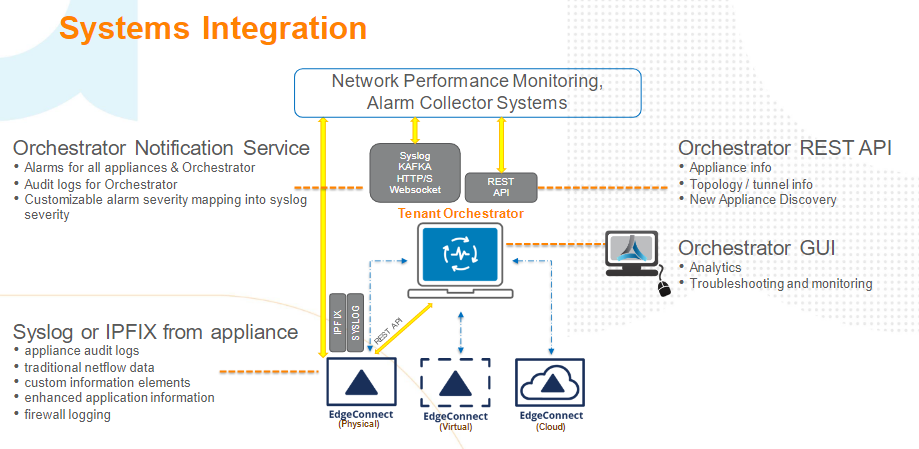Overview of HPE Aruba Networking EdgeConnect Integration Points
EdgeConnect Integration endpoints
HPE Aruba Networking EdgeConnect supports multiple integration points to support both northbound monitoring as well as southbound configuration & provisioning of the SD-WAN. The set of APIs and management protocols that comprise EdgeConnect integration strategy enables customers to achieve extensive automation and integration with a number of external partner Operation support (OSS) or Business support (BSS) systems as well as general-purpose IT systems.
For example through APIs, customers can:
-
Aggregate alarms and events across the SD-WAN into Security Information and Event Management (SIEM) or
fault monitoring platforms -
Gather and monitor performance statistics on SD-WAN resources and services
-
Enable workflow automation through various configuration APIs
-
Discover network topology for building alarm correlation intelligence
HPE Aruba Networking offers multiple integration levels, depending on the scope and type of information or control that is enabled.
These levels include:
-
Appliance level: this reference point applies natively offered network management protocols and/or fine-granular information that is only stored locally on the appliances.
-
Orchestrator level: this reference point provides an SD-WAN fabric-wide view that encompasses not just the EdgeConnect appliances under its purview, but also access to resources and network-level information maintained at the Orchestrator level, such as topology, Business Intent Overlays, and application policies.
-
Orchestrator-SP and Orchestrator Global Enterprise level: for multi-tenant or multi-fabric SD-WAN deployments customers may leverage Orchestrator-SP or Orchestrator Global Enterprise to help them manage these deployments. In those situations, customers can access APIs at the Orchestrator-SP and Orchestrator Global Enterprise level to gain visibility and control over their multi-tenant environments.

Updated over 1 year ago
To learn more about REST APIs and how to use them go to the linked below.